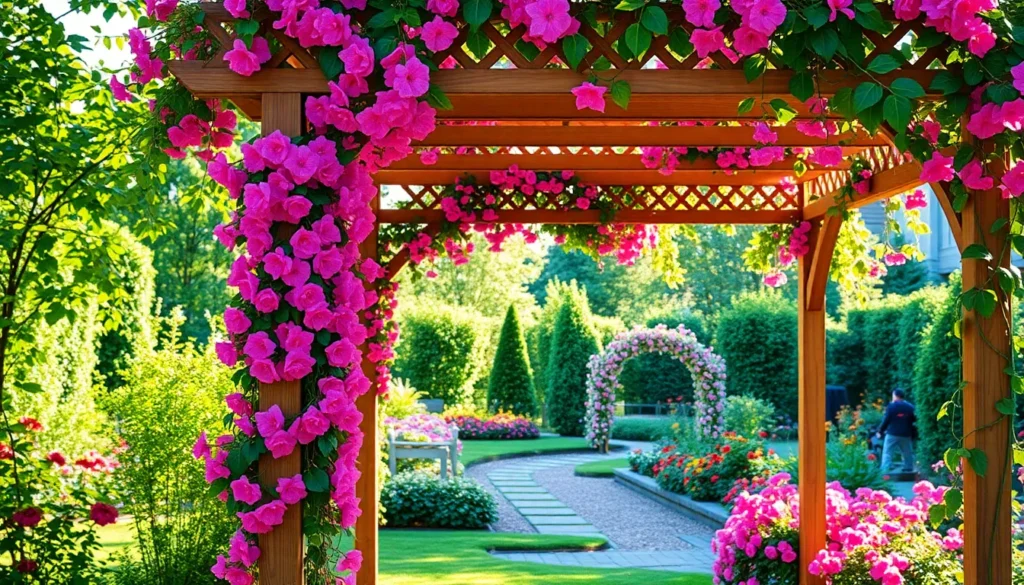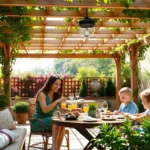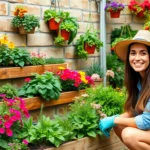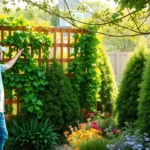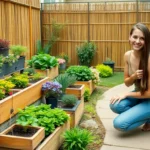Garden arbors transform ordinary outdoor spaces into enchanting retreats that captivate visitors and create stunning focal points. These architectural beauties serve as more than decorative elements – they’re functional structures that support climbing plants while defining pathways and garden rooms with elegant charm.
We’ve discovered that the right arbor design can dramatically enhance your industry’s visual appeal and property value. Whether you’re dreaming of a romantic rose-covered entrance or a modern geometric statement piece, countless creative possibilities await your exploration.
From rustic wooden frames to sleek metal designs, garden arbors offer endless opportunities to express your personal style while creating intimate outdoor sanctuaries. We’ll guide you through inspiring ideas that’ll help you choose the perfect arbor design for your unique space and gardening goals.
Choose the Perfect Location for Your Garden Arbor
Selecting the right spot for your garden arbor determines its long term success and visual impact. We’ll explore the key factors that ensure your arbor placement enhances both functionality and beauty.
Consider Sun and Shade Patterns
Observe your garden’s light conditions throughout different seasons to find the ideal balance for your arbor placement. Most climbing plants thrive with 6-8 hours of morning sunlight followed by afternoon shade, making east or southeast facing locations optimal choices.
Track shadow patterns during peak summer months when the sun sits highest in the sky. Areas that receive harsh afternoon sun from 2-6 PM can stress climbing vines and make sitting beneath your arbor uncomfortable during hot weather.
Position your arbor where it can provide natural shade for nearby seating areas or garden beds. This strategic placement creates a cooling microclimate while protecting delicate plants from intense midday heat.
Consider seasonal changes in sun exposure as deciduous trees lose leaves in winter. Spots that seem perfectly shaded in summer might receive too much direct sunlight during colder months when climbing plants are dormant.
Evaluate Traffic Flow and Pathways
Create natural walking routes by placing your arbor along existing foot traffic patterns in your garden. People instinctively follow established paths, so working with these tendencies ensures your arbor becomes a functional focal point.
Position arbors as gateways between different garden zones like transitioning from lawn areas to flower beds or vegetable gardens. This placement creates distinct outdoor rooms while maintaining smooth circulation flow.
Ensure adequate clearance of at least 8 feet in height and 4 feet in width for comfortable passage once climbing plants mature. Dense foliage can reduce these dimensions significantly over time.
Avoid blocking sight lines to important garden features or safety areas like pool zones and outdoor lighting. Your arbor should frame views rather than obstruct them completely.
Assess Soil Drainage and Ground Conditions
Test drainage quality by digging a hole 12 inches deep and filling it with water during different weather conditions. Soil that drains within 6-8 hours supports healthy root development for climbing plants.
Identify problematic areas where water pools after rain or irrigation, as these soggy conditions promote root rot and structural instability. Heavy clay soils often require amendment or drainage answers before arbor installation.
Check underground utilities by calling your local utility marking service before digging post holes. Gas lines, electrical cables, and water pipes can limit placement options and create safety hazards.
Evaluate ground stability for anchoring posts securely, especially on sloped terrain or sandy soils. Areas with solid, well draining earth provide the best foundation for long lasting arbor structures.
Select Materials That Match Your Garden Style
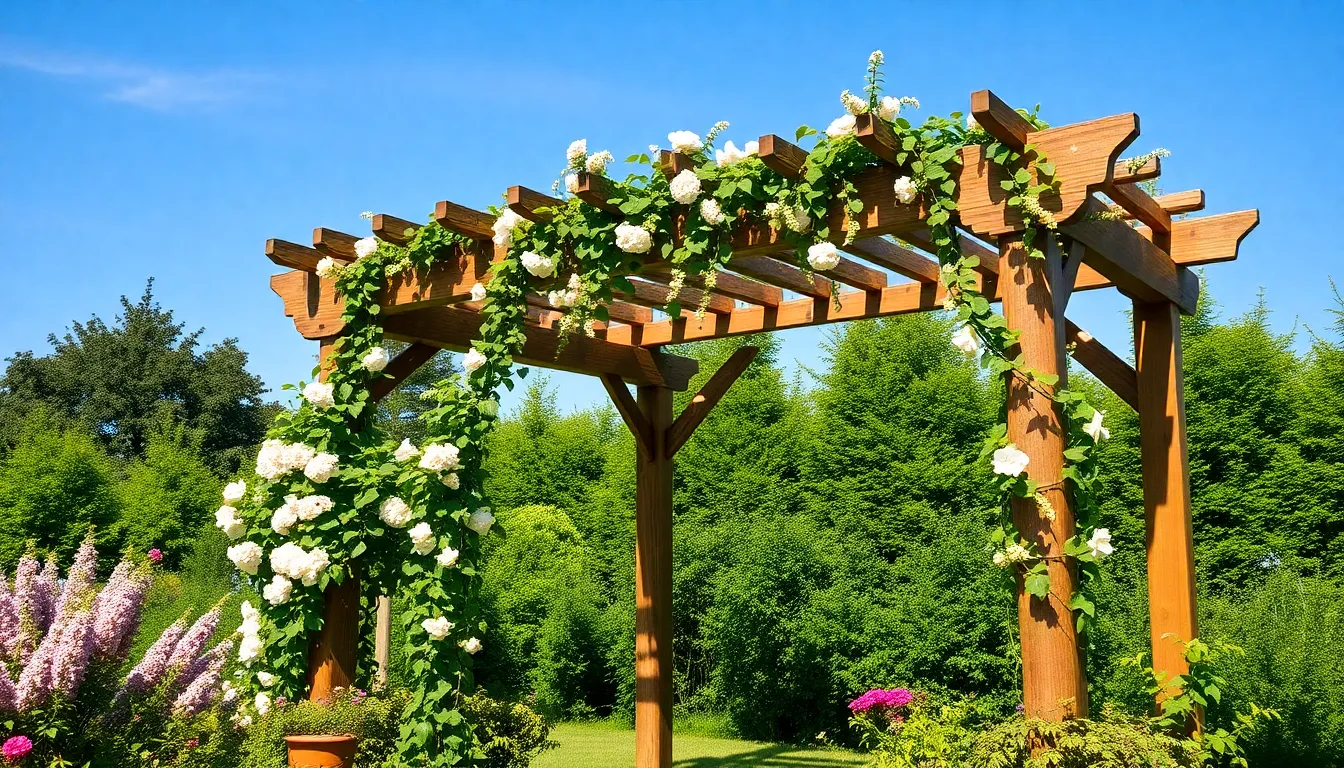
Choosing the right material for your garden arbor sets the foundation for both its aesthetic appeal and long-term durability. We’ll explore three primary material categories that cater to different design preferences and maintenance requirements.
Wood Arbors for Natural Charm
Wood creates an organic connection between your arbor and surrounding industry elements. Cedar and redwood stand out as premium choices due to their natural resistance to moisture and rot, ensuring your structure remains beautiful for years. We recommend these species because they handle outdoor conditions exceptionally well without requiring extensive chemical treatments.
Staining and painting options allow you to customize wooden arbors to match your existing garden theme perfectly. Traditional looks emerge naturally with wood’s inherent grain patterns and warm tones. Consider incorporating wood lattice paneling for added visual texture, or design a custom trellis pattern that reflects your personal style.
Design flexibility makes wood particularly appealing for gardeners who enjoy DIY projects. You can easily modify wooden structures, add decorative elements, or create unique shapes that complement your garden’s personality.
Metal Arbors for Modern Appeal
Metal materials bring contemporary sophistication to garden spaces with their clean lines and geometric possibilities. Steel, aluminum, and copper each offer distinct advantages in terms of durability and design flexibility. We find that metal arbors particularly excel in urban landscapes where modern architectural elements dominate.
Sleek appearances characterize metal arbors, making them ideal for minimalist garden designs. Contemporary geometric patterns can transform a simple walkway into an artistic focal point. Modern homeowners appreciate how metal structures maintain their shape and appearance with minimal upkeep.
Visual interest develops naturally when you incorporate blooming vines onto metal frameworks. The contrast between organic plant growth and structured metal creates striking combinations that enhance your garden’s overall appeal.
Vinyl and Composite Options for Low Maintenance
Vinyl arbors deliver exceptional value through their resistance to decay and insects, requiring virtually no ongoing maintenance. We recommend vinyl for busy homeowners who want beautiful garden structures without regular upkeep commitments. These materials won’t warp, crack, or require annual staining like traditional wood options.
Versatility defines vinyl’s greatest strength, offering both functional performance and aesthetic flexibility. Modern manufacturing techniques allow vinyl to mimic traditional wood appearances while providing superior weather resistance. You can achieve classic looks without the associated maintenance requirements.
Design options range from traditional wood grain textures to smooth contemporary finishes. Vinyl arbors adapt to various garden styles, whether you prefer rustic charm or modern minimalism.
Design Classic Wooden Garden Arbors
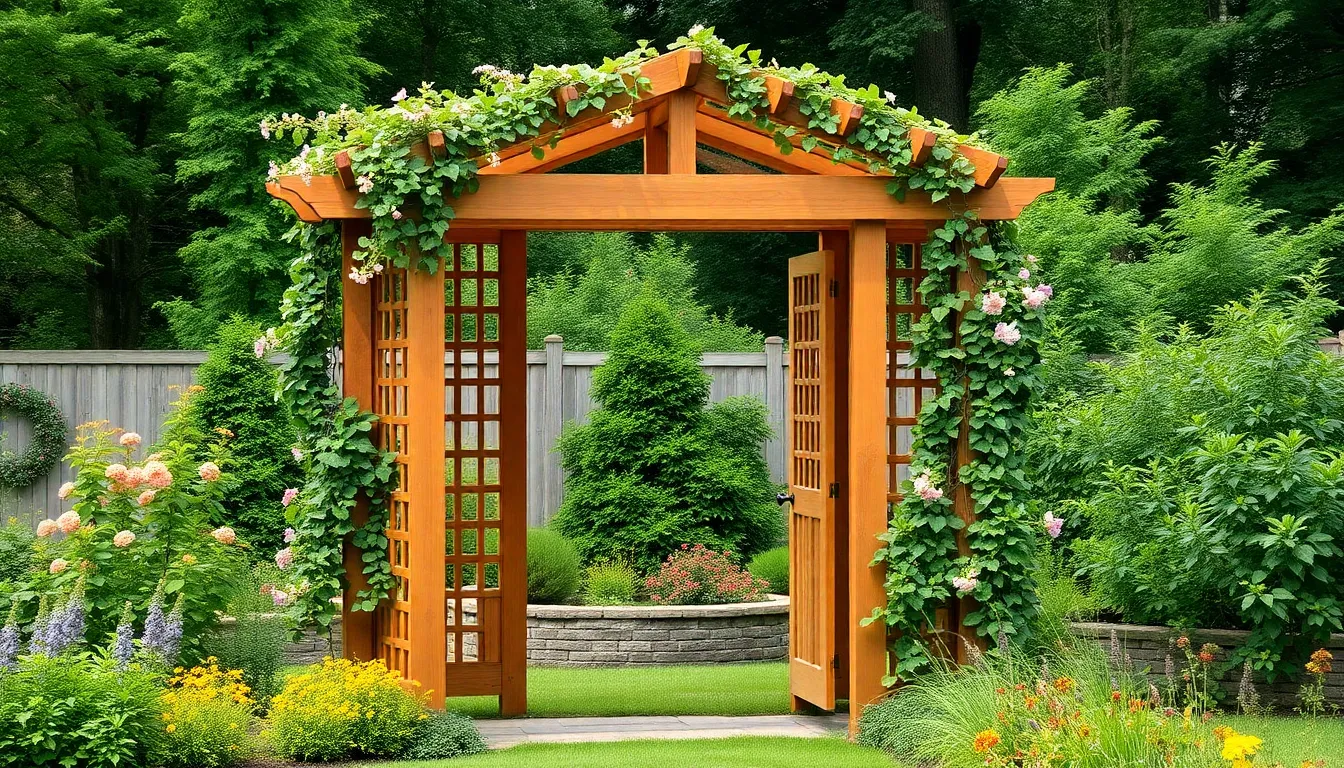
Classic wooden garden arbors bring timeless elegance to outdoor spaces while providing the perfect foundation for climbing plants and creating stunning focal points.
Cedar Arbor with Lattice Sides
Cedar stands out as the most popular choice for garden arbors due to its natural resistance to rot and insects. This durable wood develops a beautiful silver-gray patina over time, adding character to your garden without requiring frequent maintenance. We recommend incorporating lattice panels on the sides to create an ideal growing surface for climbing vines like clematis, roses, or jasmine.
Lattice benefits include:
- Enhanced support for heavier climbing plants
- Natural wind resistance while maintaining airflow
- Increased privacy as plants mature
- Decorative appeal even before plant establishment
The lattice design allows climbing vines to weave through naturally, creating a lush and organic appearance that transforms your arbor into a living sculpture.
Rustic Log Arbor Construction
Weathered wood creates an authentic rustic charm that complements cottage gardens and natural landscapes perfectly. We suggest using reclaimed barn wood or naturally aged cedar logs to achieve this distinctive look. The key lies in embracing imperfections like knots, grain patterns, and weathering marks that tell a story.
Construction tips for rustic appeal:
- Select logs with varying diameters for organic asymmetry
- Leave bark intact in strategic areas for texture
- Use traditional joinery methods like mortise and tenon
- Add vintage accents such as antique lanterns or weathered garden tools
This approach creates a nostalgic atmosphere that transports visitors to simpler times while providing a sturdy structure for decades of enjoyment.
Painted White Picket Arbor
White painted arbors offer versatility and elegance that complements virtually any garden style. This classic approach mimics traditional picket fence aesthetics while providing a clean, neutral backdrop for vibrant flowers and lush greenery. We find that white arbors create striking contrast against deep green foliage and colorful blooms.
White arbor advantages:
- Reflects light to brighten shaded garden areas
- Makes small spaces appear larger and more open
- Coordinates with existing white garden features
- Easy to refresh with periodic repainting
The crisp white finish works exceptionally well in formal gardens, cottage landscapes, and modern minimalist designs. Consider using high-quality exterior primer and paint specifically formulated for outdoor wood to ensure lasting beauty and protection against weather elements.
Create Modern Metal Arbor Structures
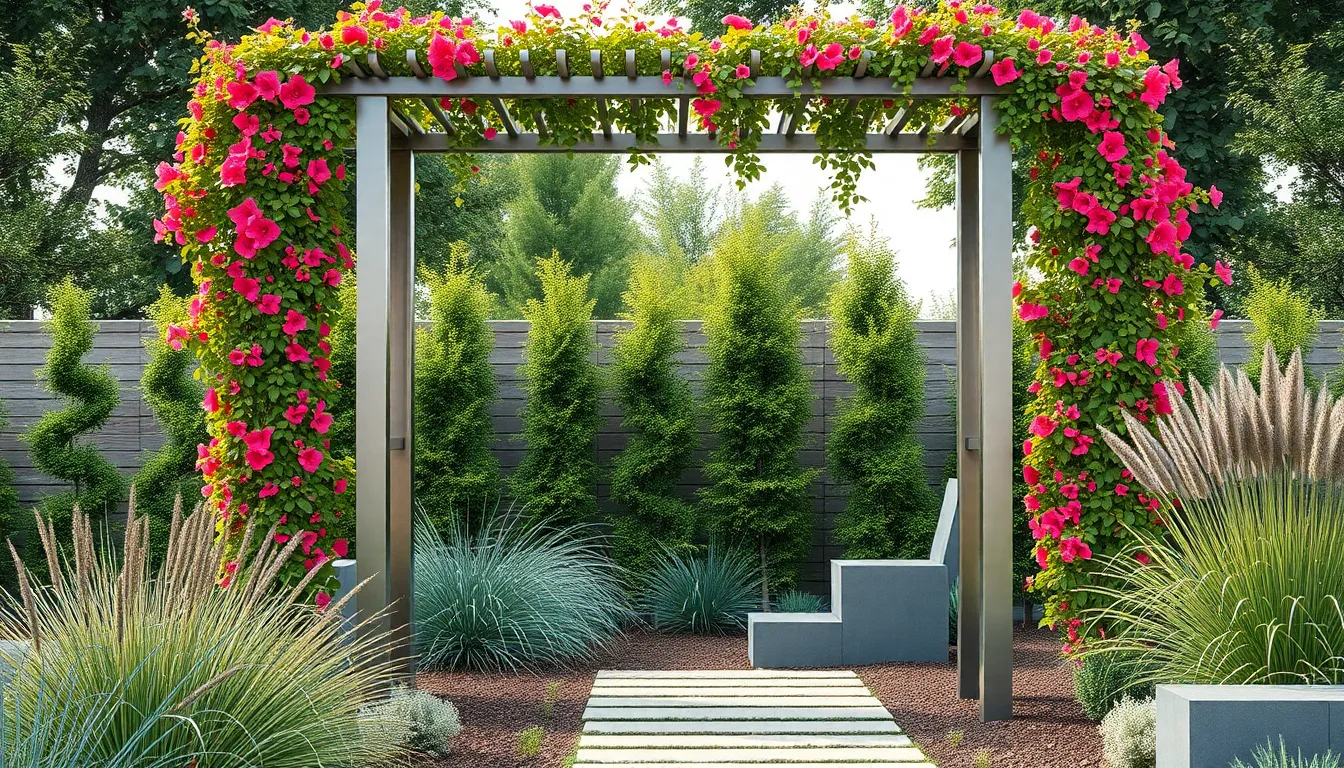
Modern metal arbors bring sophisticated elegance to contemporary gardens while offering exceptional durability and low maintenance requirements.
Sleek Steel Geometric Designs
Geometric steel arbors transform outdoor spaces with their clean lines and minimalistic aesthetics. These contemporary structures feature bold shapes like circles, triangles, and rectangles that create striking architectural focal points in modern garden designs.
Steel construction provides robust support for climbing plants while maintaining structural integrity through various weather conditions. We recommend choosing designs with powder coat finishes that resist rust and fading, ensuring your arbor maintains its sleek appearance for years.
Modern steel arbors work exceptionally well with contemporary landscaping elements like ornamental grasses, succulents, and architectural plantings. The Terra Trellis Gracie Modern Arbor exemplifies this style with its weather resistant steel frame inspired by horticultural hoop houses and moon gates.
Installation typically requires concrete footings for stability, especially when supporting heavy climbing vines like wisteria or grape varieties.
Wrought Iron Traditional Styles
Wrought iron arbors combine timeless elegance with exceptional craftsmanship, creating garden entrances that exude classic charm. Traditional wrought iron designs feature intricate scrollwork, decorative flourishes, and ornate details that complement established garden styles.
Handcrafted wrought iron arbors showcase superior metalworking skills through their detailed patterns and artistic elements. These structures develop a beautiful patina over time, adding character and authenticity to garden spaces.
Classic wrought iron designs pair beautifully with climbing roses, clematis, and jasmine, creating romantic garden passages. The substantial weight of wrought iron provides excellent stability without requiring extensive foundation work.
Maintenance involves periodic rust prevention treatments and occasional repainting to preserve the iron’s protective coating and appearance.
Powder Coated Aluminum Options
Powder coated aluminum arbors offer lightweight durability with superior corrosion resistance, making them ideal for coastal gardens and humid climates. These versatile structures come in many color options and finishes to complement any garden style.
Aluminum construction eliminates rust concerns while providing adequate strength for most climbing plants. We find these arbors particularly suitable for gardeners who prefer easy assembly and minimal maintenance requirements.
Color customization allows aluminum arbors to blend seamlessly with existing industry features or create bold contrasts for dramatic effect. The powder coating process creates a smooth, durable finish that resists chipping, fading, and weather damage.
Assembly typically involves simple bolt connections without special tools, making aluminum arbors accessible for DIY installation projects.
Build Functional Arbor and Pergola Combinations
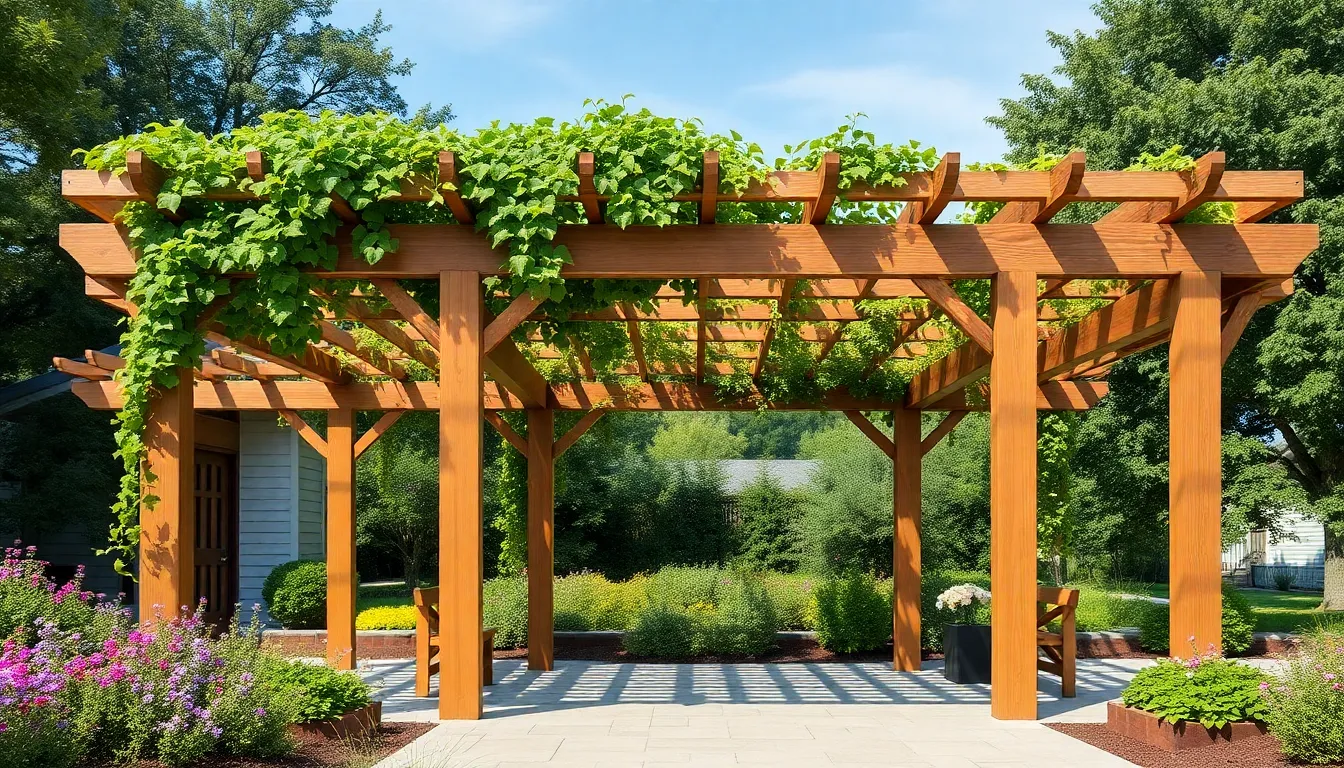
We can transform our outdoor spaces into versatile garden rooms by combining arbors with pergolas for maximum functionality and visual appeal. These integrated structures create comprehensive coverage answers that serve multiple purposes throughout our gardens.
Extended Overhead Coverage
Extended overhead coverage becomes achievable when we integrate arbors and pergolas into unified structures. These combinations provide substantial shade and protection across larger areas than individual pieces alone. Vines and climbing plants thrive on these expanded frameworks, creating natural canopies that offer both beauty and practical sun protection.
Strategic placement along walkways maximizes the extended coverage benefits. We can create shaded corridors that connect different garden zones while maintaining visual continuity. The additional overhead space supports vigorous vine growth, allowing plants like clematis, wisteria, or grape vines to spread naturally across the entire structure.
Weather resistant materials ensure our extended coverage systems last for years. Cedar, treated lumber, or powder coated metals withstand seasonal changes while supporting the weight of mature climbing plants. These durable combinations function as true outdoor rooms that provide reliable shelter for gatherings and daily garden activities.
Integrated Seating Areas
Integrated seating transforms arbor pergola combinations into multi use outdoor living spaces. Built in benches positioned beneath the structure create natural gathering spots that encourage relaxation and social interaction. We can design these seating areas to accommodate dining, reading, or simply enjoying our industry views.
Freestanding benches offer flexibility within our shaded arbor pergola spaces. These moveable options allow us to reconfigure seating arrangements for different activities or group sizes. The combination of overhead coverage and comfortable seating creates inviting environments that extend our homes into the garden.
Shaded seating areas become focal points that draw people into our outdoor spaces. The visual appeal of integrated benches beneath vine covered structures creates natural destinations within our gardens. These multi functional spaces serve dining areas, meditation spots, or conversation nooks depending on our exact needs.
Multiple Entrance Points
Multiple entrance points enhance accessibility and improve traffic flow through our garden spaces. Gated arbors at various entry points create structured transitions while maintaining privacy and defining different garden zones. These strategic openings support natural circulation patterns that accommodate both intimate gatherings and larger groups.
Open arbor entrances provide welcoming transitions between distinct garden areas. We can position multiple entry points to create logical pathways that guide visitors through our outdoor spaces. These openings eliminate bottlenecks and allow people to move freely while maintaining the structure’s visual integrity.
Several entryways support event hosting and improve overall garden functionality. The additional access points accommodate larger gatherings by preventing crowding at single entrances. We can design these multiple openings to align with natural walking patterns while creating dramatic framed views of our garden’s best features.
Incorporate Climbing Plants and Vines
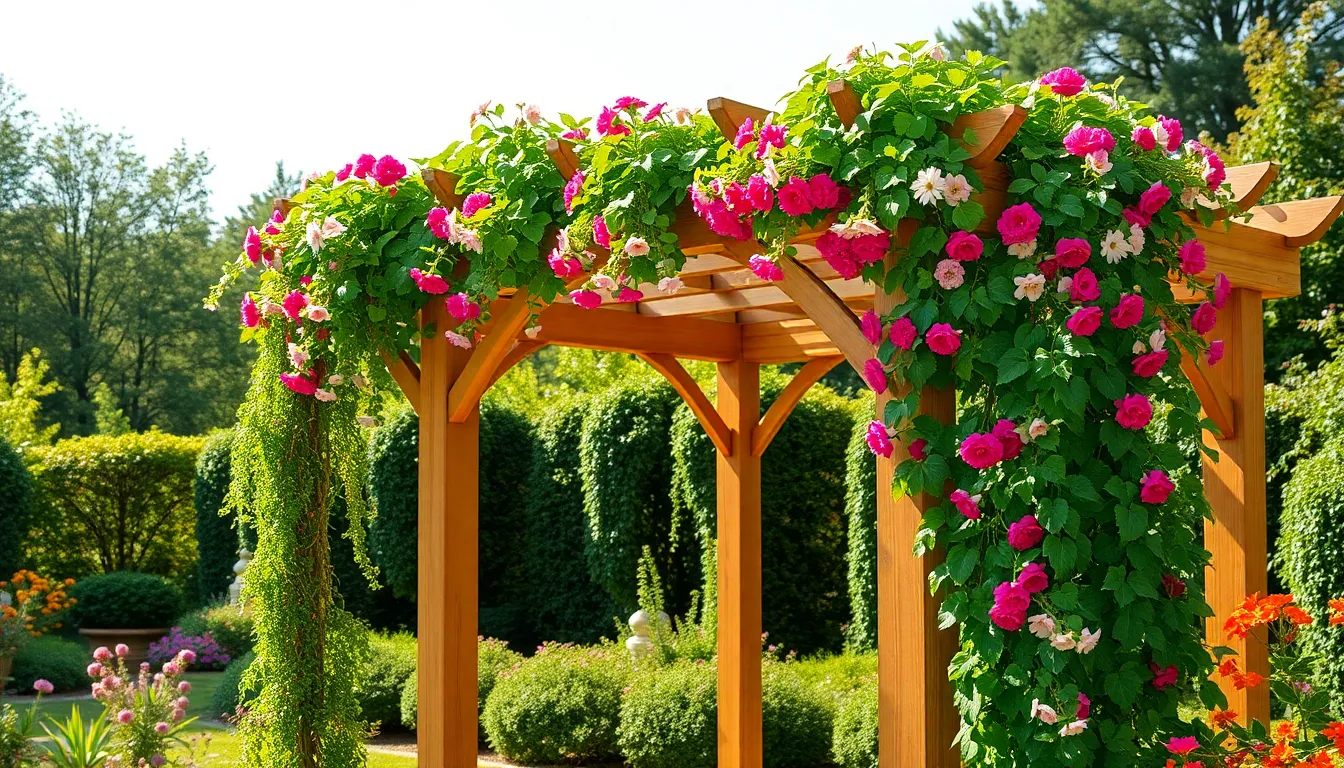
We’ll transform your garden arbor into a living masterpiece by selecting the right climbing plants and vines. The perfect combination of foliage and flowers creates natural beauty while maximizing your arbor’s visual impact.
Fast-Growing Annual Climbers
Morning Glory delivers spectacular results for gardeners seeking immediate gratification, producing vibrant blooms in purple, blue, pink, and white within just a few months. These hardy annuals spread quickly across arbor surfaces and require minimal maintenance while providing continuous color throughout the growing season.
Bougainvillea creates dramatic visual impact with its papery bracts in brilliant magenta, orange, red, and purple hues. This fast growing vine thrives in warm climates and produces lush coverage, though it may need additional support structures like wire or ties to climb effectively on arbor frames.
Sweet Peas offer delicate fragrance and pastel blooms that attract butterflies and hummingbirds to your garden space. We recommend planting these cool season climbers in early spring for best results, as they prefer moderate temperatures and consistent moisture.
Perennial Flowering Vines
Clematis stands out as one of our top choices for arbor coverage, with varieties producing blooms from spring through fall in colors ranging from deep purple to pure white. These hardy perennials require full sun exposure while keeping their roots cool and shaded, making them perfect for established arbor structures.
Climbing Roses provide classic elegance with their large, fragrant blooms and sturdy growth habit that supports arbor frameworks beautifully. Popular varieties like ‘Eden’ and ‘New Dawn’ offer repeat blooming cycles and disease resistance for long lasting garden appeal.
Honeysuckle attracts pollinators with its intensely fragrant tubular flowers while creating dense coverage on arbor surfaces. We suggest choosing native varieties to avoid invasive species issues, with options like trumpet honeysuckle providing orange red blooms that hummingbirds love.
Passionflower produces exotic, intricate blooms with unique purple and white patterns that create conversation starting focal points. These vigorous climbers use tendrils to grip arbor supports and can produce edible fruit in warmer growing zones.
Evergreen Coverage Options
Evergreen Clematis varieties like ‘Armandii’ maintain their foliage year round while producing clusters of fragrant white flowers in early spring. These robust climbers provide consistent coverage during winter months when deciduous vines lose their leaves.
English Ivy creates reliable year round coverage with its glossy green foliage that adapts to various light conditions. We recommend regular pruning to control growth and prevent damage to arbor structures, as this vigorous climber can become quite heavy over time.
Carolina Jessamine offers bright yellow flowers in late winter and early spring while maintaining evergreen foliage in milder climates. This native vine provides excellent coverage for southern gardens and attracts early season pollinators when few other plants are blooming.
Add Decorative Elements and Lighting
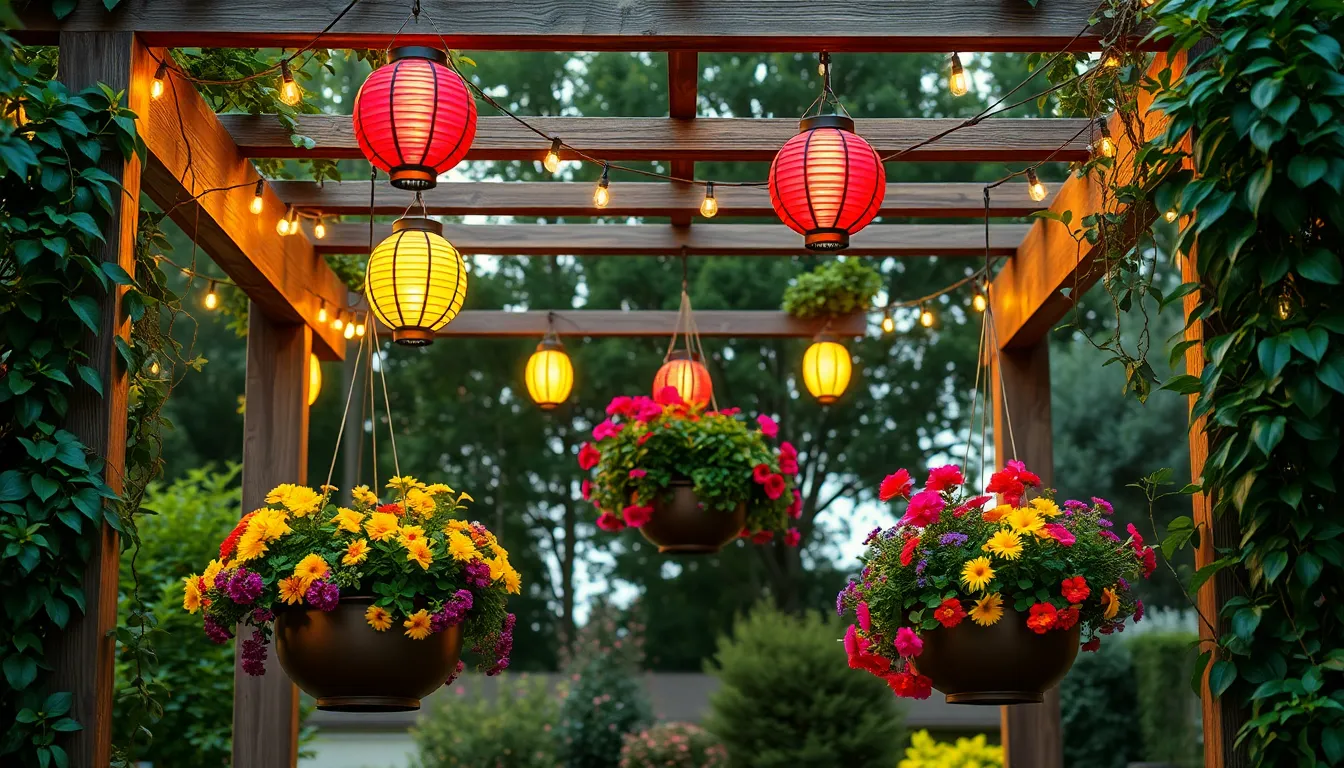
We can transform our garden arbors into enchanting focal points by incorporating carefully chosen decorative elements and lighting features. These additions create magical ambiance while extending the usability of our outdoor spaces beyond daylight hours.
String Lights and Lanterns
String lights create instant magic when draped across arbor structures, transforming our garden spaces into romantic evening retreats. We’ll find that LED string lights offer energy efficiency and longevity while providing warm, inviting illumination that highlights the arbor’s architectural details. Solar powered options eliminate the need for electrical connections and automatically illuminate our pathways at dusk.
Lanterns suspended from arbor crossbeams add vertical interest and focused lighting pools beneath the structure. Traditional hanging lanterns complement rustic wooden arbors, while sleek modern fixtures enhance contemporary metal designs. Battery operated lanterns provide flexibility in placement without requiring permanent wiring installations.
Twinkling fairy lights woven through lattice panels create a starry canopy effect that enchants visitors and extends evening garden enjoyment. We can adjust brightness levels throughout the seasons, using dimmer controls to create subtle background lighting or bright task illumination for outdoor dining.
Hanging Planters and Baskets
Hanging planters suspended from arbor frames add layers of greenery and flowers that enhance the structure’s vertical dimension. We’ll discover that cascading plants like trailing petunias, lobelia, and ivy geraniums create dramatic waterfall effects that soften harsh architectural lines. These elevated plantings draw the eye upward while maximizing growing space in compact garden areas.
Tiered hanging baskets at varying heights create visual rhythm and accommodate different plant varieties with exact light requirements. Coconut fiber lined baskets provide excellent drainage while maintaining a natural aesthetic that complements both wooden and metal arbor materials. Self watering planters reduce maintenance demands while ensuring consistent moisture for optimal plant health.
Seasonal rotation of hanging displays keeps our arbor looking fresh throughout the growing season, with spring bulbs giving way to summer annuals and autumn mums. We can coordinate hanging basket colors with climbing vine blooms to create cohesive color schemes that enhance the overall garden design.
Wind Chimes and Garden Art
Wind chimes positioned within arbor structures create gentle musical elements that enhance the sensory garden experience. We’ll find that bamboo chimes complement Asian inspired arbor designs, while metal chimes with deeper tones suit contemporary installations. Strategic placement ensures optimal air circulation for consistent sound without overwhelming nearby seating areas.
Garden art pieces mounted on arbor posts or crossbeams serve as focal points that reflect our personal style and garden theme. Decorative metal sculptures, ceramic plaques, and stained glass panels catch and reflect light while adding artistic interest to the structure. Weather resistant materials ensure longevity through seasonal changes and harsh weather conditions.
Sculptural elements like decorative brackets, finials, and corner embellishments transform basic arbor frames into custom architectural features. We can select ornamental hardware that matches our home’s exterior style, creating visual continuity between indoor and outdoor living spaces while adding sophisticated finishing touches to our garden arbors.
Design Arbors for Specific Garden Areas
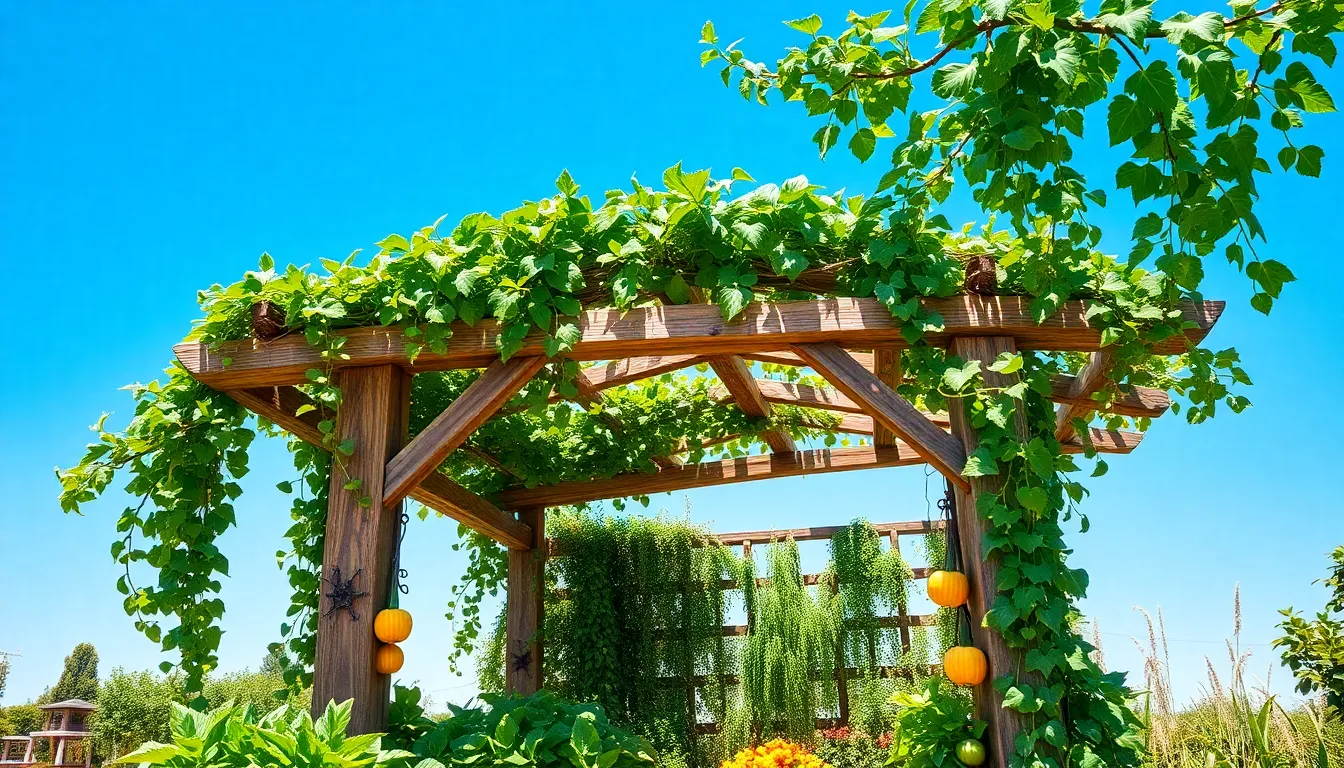
We’ve explored various arbor styles and materials, but the key to creating truly stunning garden features lies in matching your arbor design to its exact location and purpose.
Vegetable Garden Entrances
Rustic wooden arbors create the perfect welcoming entrance to vegetable gardens, offering natural charm that complements productive growing spaces. Cedar and weathered wood options provide durability while maintaining an authentic, farmhouse aesthetic that ages beautifully over time.
Functional vine integration transforms these entrance arbors into productive elements by supporting grapevines or other edible climbers. This approach delivers both visual appeal and fresh produce, maximizing the utility of your garden space.
Simple trellis style designs mark the transition from ornamental areas to productive vegetable spaces without overwhelming the natural industry. These understated structures create clear boundaries while maintaining visual harmony throughout your garden design.
Vintage accent additions like weathered lanterns or antique garden tools enhance the nostalgic appeal of vegetable garden entrances. These decorative elements reinforce the traditional, homegrown atmosphere that makes vegetable gardens so inviting.
Rose Garden Focal Points
White painted arbors create stunning focal points in rose gardens by providing dramatic contrast against red and pink blooms. This classic picket fence style approach makes rose colors pop while establishing an elegant, timeless aesthetic.
Metal arched designs with scrollwork or geometric patterns add sophisticated durability to rose garden displays. These structures support climbing roses effectively while introducing architectural interest that complements formal garden layouts.
Strategic central positioning transforms arbors into natural frames that highlight rose collections and create picturesque garden vignettes. End of path placement draws visitors deeper into the garden while showcasing your most prized rose varieties.
Climbing rose integration turns arbors into living sculptures as roses mature and cover the structure. This partnership between hardscape and plantings creates the romantic, cottage garden atmosphere that rose enthusiasts cherish.
Pathway Transitions
Corridor style arbors covered in climbing vines provide shaded walkways that segment gardens both visually and functionally. These extended structures create dramatic passages that guide visitors through different garden zones with clear definition.
Dramatic entrance features using larger, flower adorned arbors act as symbolic doorways between garden sections. These substantial structures signal transitions while creating anticipation for what lies beyond.
Brick pathway pairings enhance the manicured appearance of garden arbors while providing stable, elegant walking surfaces. This combination creates sophisticated garden architecture that guides visitors gracefully through the industry.
Integrated bench designs offer rest points along longer pathways, combining beauty with practical comfort. These multifunctional structures encourage visitors to pause and enjoy garden views while providing structural interest year round.
Consider Size and Scale Proportions
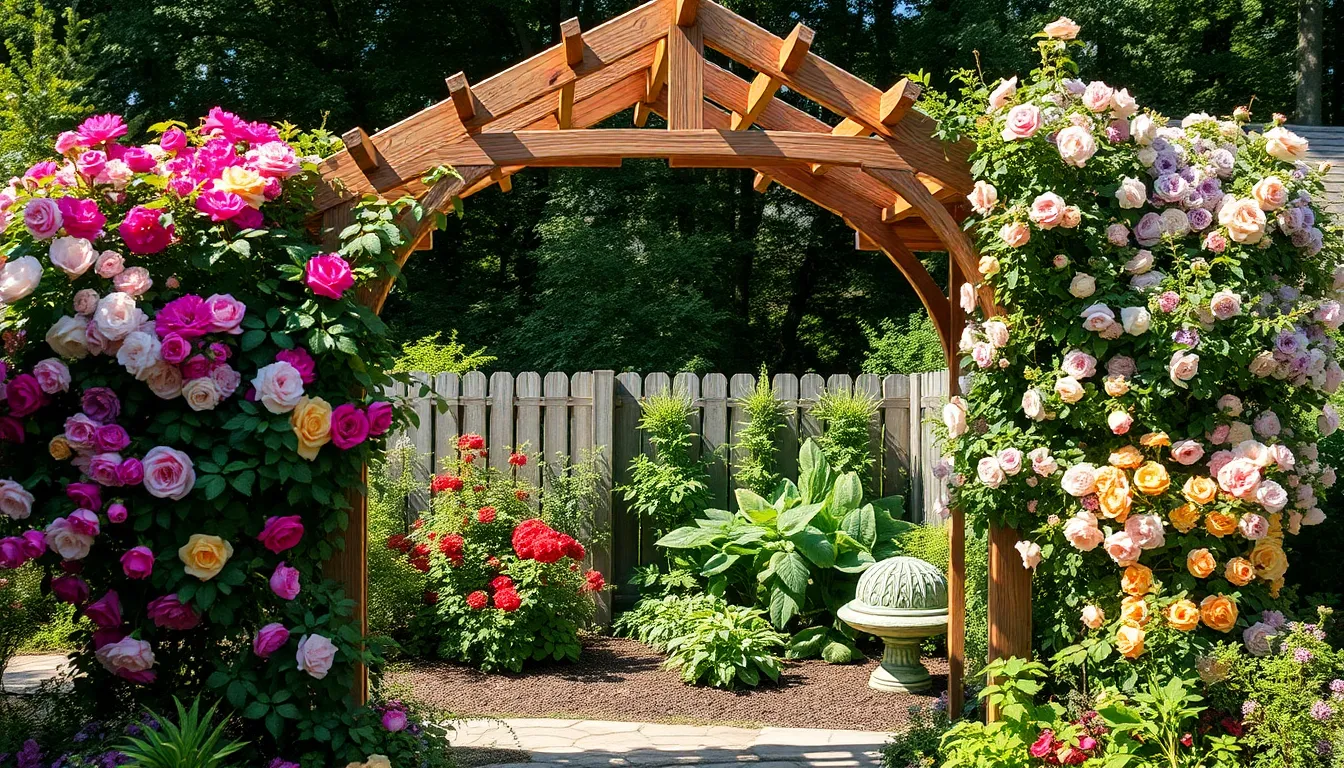
Selecting the right arbor size directly impacts your garden’s visual harmony and functionality. We must balance proportions to ensure our arbor complements rather than overwhelms the surrounding industry.
Small Garden Arbor Answers
Compact gardens benefit from carefully sized arbors that maximize impact without consuming precious space. Rustic wooden arbors crafted from weathered cedar or reclaimed pine create natural charm while maintaining modest footprints. We recommend dimensions of 6-8 feet in height and 4-5 feet in width for optimal proportions in smaller areas.
Japanese style arbors offer minimalist elegance through clean bamboo or cedar construction. These designs typically feature heights of 7 feet with 3-4 foot widths, incorporating Shoji screen panels and stone lantern accents for authentic aesthetic appeal. Strategic placement near garden corners or pathway transitions enhances their visual impact.
Trellised mini arbors provide vertical growing space while occupying minimal ground area. We suggest installing these 5-6 foot structures along fence lines or property borders where climbing roses and clematis can flourish without spreading into walkways.
Large Statement Arbor Designs
Expansive gardens accommodate dramatic arbor installations that serve as commanding focal points. Floral archway arbors spanning 10-12 feet in width create magical garden entrances when adorned with vigorous climbing vines like wisteria and honeysuckle. These substantial structures require concrete footings and reinforced posts to support mature plant weight.
Corridor style arbors extend 15-20 feet in length, forming tunnel like passages that provide extensive shade coverage. We design these elongated structures with 8-9 foot heights and integrated bench seating every 6 feet for comfortable rest stops along garden pathways.
Multi arch configurations combine three or more connected arches to create grand garden statements. These installations work exceptionally well in formal landscapes where symmetry and repetition enhance overall design coherence.
Adjustable and Expandable Options
Flexible arbor systems adapt to changing garden needs and growing plant requirements over time. Modular metal arbors feature removable side panels and adjustable height extensions that accommodate expanding vine growth. We recommend starting with basic 7-foot frames and adding 2-foot extensions as plants mature.
Expandable trellis arbors incorporate removable lattice sections that increase growing surface area. These designs allow us to begin with simple arched frames and gradually add side panels, creating custom configurations that match plant development patterns.
Convertible bench arbors transform from simple seating areas into full overhead structures through removable top sections. This versatility proves especially valuable in new gardens where we’re still determining optimal plant placement and growth patterns.
Plan for Long-Term Maintenance and Care
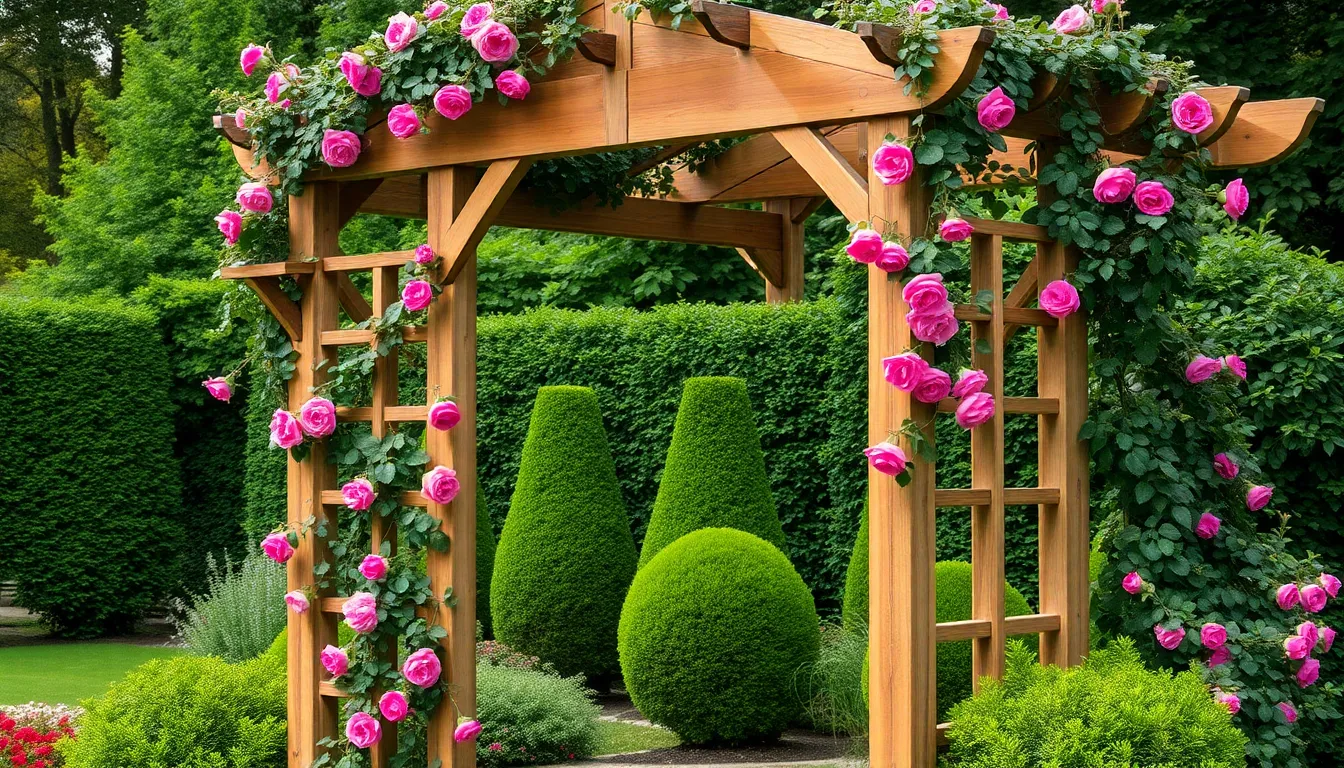
Effective maintenance ensures our garden arbors remain beautiful and structurally sound for years to come. Smart planning from the initial installation sets the foundation for manageable upkeep routines.
Seasonal Cleaning Requirements
Monthly cleaning sessions keep our arbors looking pristine throughout the growing season. We recommend using mild detergent mixed with water to gently scrub away accumulated dust, pollen, and organic debris from all surfaces.
Spring cleaning should focus on removing winter debris and inspecting for any damage caused by harsh weather conditions. Summer maintenance involves clearing away dead plant material and checking for pest infestations that might affect both the structure and climbing plants.
Fall preparation includes removing fallen leaves from the base area and applying protective treatments before winter arrives. Winter inspections help us identify any structural issues that developed during the dormant season, allowing for timely repairs before spring growth begins.
Base area maintenance requires regular clearing to prevent moisture buildup and pest problems. We should remove weeds, fallen branches, and accumulated organic matter that could harbor insects or create drainage issues around the arbor foundation.
Plant Pruning and Training
Strategic plant selection dramatically reduces long term maintenance requirements for our garden arbors. Climbing roses, clematis, and ivy respond well to regular training and create stunning vertical displays when properly managed.
Training techniques using plant ties or soft twine guide new growth along the arbor structure without causing damage. We should check these supports monthly during the growing season, adjusting them as plants expand and mature.
Pruning schedules vary by plant type, but most climbing varieties benefit from regular trimming to maintain their health and prevent structural damage. Dead heading spent blooms encourages continued flowering while removing diseased or damaged stems protects the overall plant health.
Weight management becomes crucial as climbing plants mature and could potentially stress the arbor framework. We need to thin out excessive growth periodically to maintain the structural integrity of both plants and support system.
Structural Repairs and Updates
Regular joint inspections prevent small issues from becoming major structural problems over time. We should check and tighten loose bolts, screws, and connecting hardware at least twice yearly, particularly after severe weather events.
Protective coating applications extend the lifespan of metal components significantly, with annual treatments preventing rust formation and corrosion. Wood arbors benefit from staining or sealing every two to three years depending on climate conditions and wood type.
Foundation stability requires ongoing attention to prevent shifting or settling that could compromise the entire structure. We need to ensure the arbor remains securely anchored to its base, adding additional support stakes if necessary.
Material exact maintenance schedules help us stay proactive rather than reactive with our arbor care. Metal structures need rust prevention measures, wooden arbors require moisture protection, and vinyl options need periodic deep cleaning to maintain their appearance.
Conclusion
We’ve explored a comprehensive range of garden arbor ideas that can truly transform your outdoor space into something extraordinary. From classic wooden designs to modern metal structures each option offers unique benefits that cater to different styles and functional needs.
The key to success lies in thoughtful planning – choosing the right location materials and complementary elements that work together harmoniously. Whether you’re creating an enchanting entrance to your vegetable garden or establishing a romantic pathway through your roses the perfect arbor awaits your personal touch.
Remember that your garden arbor is an investment that grows more beautiful over time. With proper plant selection regular maintenance and creative decorative touches you’ll create a living masterpiece that enhances your property value while providing years of outdoor enjoyment.
Frequently Asked Questions
What is a garden arbor and what are its main benefits?
A garden arbor is both a decorative and functional structure that enhances outdoor spaces. It serves as an architectural focal point while providing support for climbing plants. The main benefits include improving visual appeal, increasing property value, creating natural walking routes, and offering versatility in design styles from rustic to modern.
How do I choose the best location for my garden arbor?
Consider sun and shade patterns to ensure optimal light for climbing plants, evaluate traffic flow to create natural pathways, and assess soil drainage and ground conditions for stability. Strategic placement should enhance functionality, maintain sight lines, and ensure comfortable passage as plants mature over time.
What materials are best for garden arbors?
The three primary materials are wood, metal, and vinyl/composite. Wood offers natural charm and customization options through staining and painting. Metal provides modern appeal with minimal upkeep and clean lines. Vinyl arbors offer low maintenance and weather resistance while mimicking traditional wood aesthetics.
Which climbing plants work best with garden arbors?
Fast-growing annuals like Morning Glory and Bougainvillea provide immediate impact, while Sweet Peas add fragrance. Perennial flowering vines such as Clematis and Climbing Roses offer long-lasting blooms. Evergreen options like Evergreen Clematis and English Ivy provide year-round coverage and visual interest.
How can I enhance my garden arbor with decorative elements?
Add string lights and lanterns for evening ambiance, incorporate hanging planters and baskets for layered greenery, and include wind chimes or garden art for sensory enhancement. These elements transform arbors into enchanting focal points that remain visually appealing throughout all seasons.
What size arbor should I choose for my garden space?
For small gardens, choose compact designs that don’t overwhelm the space. Larger, expansive areas can accommodate statement arbors that serve as dramatic focal points. Consider adjustable and expandable arbor options that can adapt to changing garden needs and growth over time.
How do I maintain my garden arbor properly?
Perform monthly cleaning and seasonal maintenance tasks including spring inspections, summer plant training, fall preparation, and winter protection. Regular structural inspections, plant pruning, and timely repairs prevent major issues and ensure your arbor remains beautiful and structurally sound for years.
Can I combine arbors with other garden structures?
Yes, combining arbors with pergolas creates versatile outdoor spaces with extended overhead coverage and shade. These integrated structures support vigorous vine growth, enhance visual continuity, and can include seating areas and multiple entrance points for improved accessibility and social interaction.

